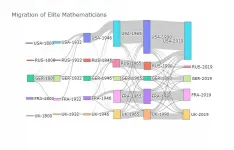(Press-News.org) People are adept at discerning most of the different emotions that underlie screams, such as anger, frustration, pain, surprise or fear, finds a new study by psychologists at Emory University. Screams of happiness, however, are more often interpreted as fear when heard without any additional context, the results show.
PeerJ published the research, the first in-depth look at the human ability to decode the range of emotions tied to the acoustic cues of screams.
"To a large extent, the study participants were quite good at judging the original context of a scream, simply by listening to it through headphones without any visual cues," says Harold Gouzoules, Emory professor of psychology and senior author of the study. "But when participants listened to screams of excited happiness they tended to judge the emotion as fear. That's an interesting, surprising finding."
First author of the study is Jonathan Engelberg, an Emory Ph.D. student of psychology. Emory alum Jay Schwartz, who is now on the faculty of Western Oregon University, is co-author.
The acoustic features that seem to communicate fear are also present in excited, happy screams, the researchers note. "In fact, people pay good money to ride roller coasters, where their screams no doubt reflect a blend of those two emotions," Gouzoules says.
He adds that the bias towards interpreting both of these categories as fear likely has deep, evolutionary roots.
"The first animal screams were probably in response to an attack by a predator," he says. "In some cases, a sudden, loud high-pitched sound might startle a predator and allow the prey to escape. It's an essential, core response. So mistaking a happy scream for a fearful one could be an ancestral carryover bias. If it's a close call, you're going to err on the side of fear."
The findings may even provide a clue to the age-old question of why young children often scream while playing.
"Nobody has really studied why young children tend to scream frequently, even when they are happily playing, but every parent knows that they do," Gouzoules says. "It's a fascinating phenomenon."
While screams can convey strong emotions, they are not ideal as individual identifiers, since they lack the more distinctive and consistent acoustic parameters of an individual's speaking voice.
"It's just speculative, but it may be that when children scream with excitement as they play, it serves the evolutionary role of familiarizing a parent to the unique sound of their screams," Gouzoules says. "The more you hear your child scream in a safe, happy context, the better able you are to identify a scream as belonging to your child, so you will know to respond when you hear it."
Gouzoules first began researching the screams of non-human primates, decades ago. Most animals scream only in response to a predator, although some monkeys and apes also use screams to recruit support when they are in a fight with other group members. "Their kin and friends will come to help, even if some distance away, when they can recognize the vocalizer," he says.
In more recent years, Gouzoules has turned to researching human screams, which occur in a much broader context than those of animals. His lab has collected screams from Hollywood movies, TV shows and YouTube videos. They include classic performances by "scream queens" like Jaime Lee Curtis, along with the screams of non-actors reacting to actual events, such as a woman shrieking in fear as aftershocks from a meteor that exploded over Russia shake a building, or a little girl's squeal of delight as she opens a Christmas present.
In previous work, the lab has quantified tone, pitch and frequency for screams from a range of emotions: Anger, frustration, pain, surprise, fear and happiness.
For the current paper, the researchers wanted to test the ability of listeners to decode the emotion underlying a scream, based solely on its sound. A total of 182 participants listened through headphones to 30 screams from movies that were associated with one of the six emotions. All of the screams were presented six times, although never in sequence. After hearing a scream, the listeners rated how likely it was associated with each of six of the emotions, on a scale of one to five.
The results showed that the participants most often matched a scream to its correct emotional context, except in the case of screams of happiness, which participants more often rated highly for fear.
"Our work intertwines language and non-verbal communication in a way that hasn't been done in the past," Gouzoules says.
Some aspects of non-verbal vocal communication are thought to be precursors for language. The researchers hypothesize that it may be that the cognitive underpinnings for language also built human capacity in the non-verbal domain. "It's probably language that gives us this ability to take a non-verbal vocalization and discern a wide range of meanings, depending on the acoustic cues," Gouzoules says.
INFORMATION:
WHAT:
When variants of SARS-CoV-2 (the virus that causes COVID-19) emerged in late 2020, concern arose that they might elude protective immune responses generated by prior infection or vaccination, potentially making re-infection more likely or vaccination less effective. To investigate this possibility, researchers from the National Institute of Allergy and Infectious Diseases (NIAID), part of the National Institutes of Health, and colleagues analyzed blood cell samples from 30 people who had contracted and recovered from COVID-19 prior to the emergence of virus variants. They found that one key player in the immune response to SARS-CoV-2--the CD8+ T cell--remained active against the virus.
The research team was led by NIAID's Andrew Redd, Ph.D., and included ...
Indigenous traditions often place land at the centre of their cultures. However, with more than half of Canada's Indigenous population now living in urban areas and Indigenous communities struggling to overcome legacies of colonialism defined by assimilation and land theft, that connection is getting frayed.
Elizabeth Fast, an associate professor of applied human sciences in the Faculty of Arts and Science, wanted to help Indigenous youth reconnect with their cultures in safe and accessible ways. Along with a youth advisory group composed of Indigenous youth (some of whom are also students), she has been organizing a series of land-based learning retreats ...
BOSTON - (March 25, 2021) - A mechanism has been identified that explains how physical exercise in pregnancy confers metabolic health benefits in offspring. According to researchers, the key lies with a protein called SOD3, vitamin D and adequate exercise, with the outcomes possibly forming the first steps to designing rational diet and exercise programs to use during pregnancy and particularly when mothers may also be overweight or obese.
The study, which was led by authors from the Joslin Diabetes Center at the Harvard Medical School and colleagues from Japan, the US, Canada and Denmark, has been published online by Cell Metabolism.
"We've known for a while that risks for obesity and type 2 diabetes can originate in the critical ...
In a new study published in Conservation Science and Practice, researchers at the University of Maryland (UMD) partnered with Indonesian experts to explore the motivations and challenges of women pursuing a career in conservation sciences in Indonesia. Given that Indonesia is one of the most biodiverse countries on the planet but is simultaneously experiencing extreme rates of deforestation, it is an important target country for the conservation of global biodiversity. Conservation work remains male-dominated in Indonesia, especially fieldwork, so gaining a better understanding of the cultural norms and barriers in place for Indonesian women aspiring to a career in conservation represents an important step in supporting women ...
Researchers from Newcastle University, UK, working with colleagues at King Mongkut's University of Technology Thonburi (KMUTT) in Thailand and the Institute of Urban Environment of the Chinese Academy of Sciences, analysed samples of water and sediment taken from aquaculture ponds and nearby canals at five locations in central Thailand's coastal region.
The research, which was part-funded by an institutional links grant awarded by the Newton Fund via the British Council, and which has been published in the Journal of Hazardous Materials, found that the highest prevalence of antimicrobial resistance (AMR) genes was in water ...
Gas hydrates are a solid compound of gases and water that have an ice-like structure at low temperatures and high pressures. Compounds of methane and water, so-called methane hydrates, are found especially at many ocean margins - also in the Black Sea. In addition to a possible use as an energy source, methane hydrate deposits are being investigated for their stability, as they can dissolve with changes in temperature and pressure. In addition to releases of methane, this can also have an impact on submarine slope stability.
During a six-week expedition with the German research vessel METEOR in autumn 2017, a team from MARUM and GEOMAR investigated a methane hydrate deposit in the deep-sea fan of the Danube in the western Black Sea. During ...
Most businesses were ill-prepared to deal with the pandemic and muddled though the challenges stemming from it, according to a report published today.
Resilience reimagined: a practical guide for organisations was produced by Cranfield University, in partnership with the National Preparedness Commission (NPC) and Deloitte. The report presents insights from business leaders from a range of sectors and makes seven recommendations for organisations on how to become more resilient, drawing on lessons from past 12 months.
Cranfield University's Professor David Denyer and Mike Sutliff conducted in-depth interviews and four focus groups with more than 50 C-suite level people (boards, senior executives, policymakers, and resilience directors) from FTSE 100 companies, ...
As social media platforms like Instagram, Snapchat, TikTok and others continue to grow in popularity, adolescents are spending more of their time online navigating a complex virtual world.
New research suggests that these increased hours spent online may be associated with cyberbullying behaviors. According to a study by the University of Georgia, higher social media addiction scores, more hours spent online, and identifying as male significantly predicted cyberbullying perpetration in adolescents.
"There are some people who engage in cyberbullying online because of the anonymity and the fact that there's no retaliation," said Amanda Giordano, principal investigator of the study and associate professor in the UGA Mary Frances Early College of Education. "You have these ...
Math's top prize, the Fields Medal, has succeeded in making mathematics more inclusive but still rewards elitism, according to a Dartmouth study.
Published in Nature's END ...
Researchers at the Johns Hopkins Kimmel Cancer Center used machine learning techniques to detect mutational signatures in cancer patients. Their algorithm outperformed the current standard of analysis and revealed new mutational signatures associated with obesity, which is believed by cancer prevention experts to be becoming the most significant lifestyle factor contributing to cancer in the U.S. and most of the Western world.
The study was published in the Jan. 25 issue of the journal eLife.
"Mutational signatures are important in current cancer research as they enable you to see the signs left by underlying factors, such as aging, smoking, alcohol use, UV exposure, and BRCA inherited mutations that contribute to the development ...




